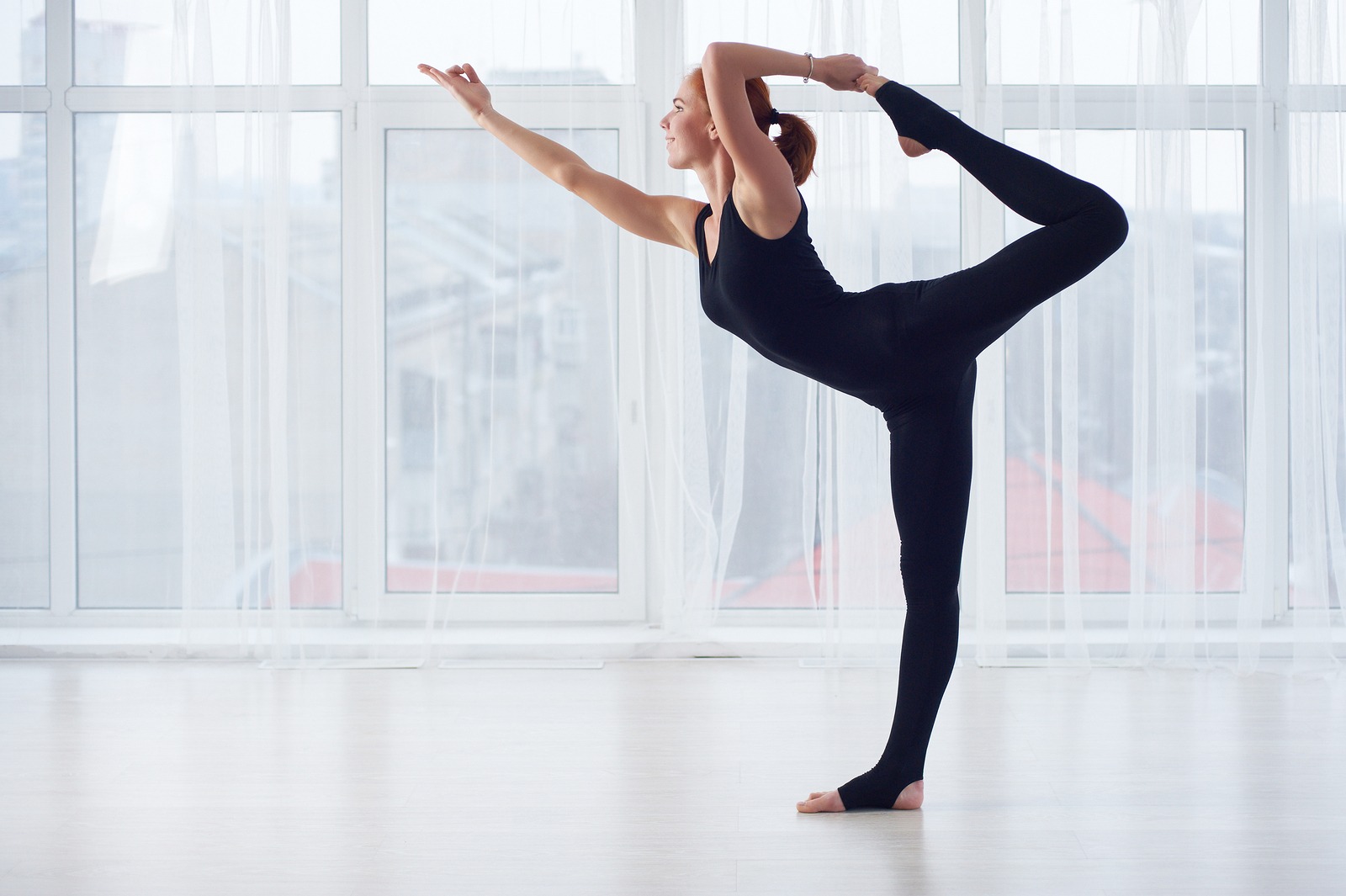The Lord of the Dance Pose is usually executed as the last pose in a series of difficult backbends.

You will likely want to relax the spine by coming to Ardha Uttanasana (Half Uttanasana), also known as Right Angle Pose, at the wall or reclining twist.
POSE INFORMATION
GENERAL INFO
Name in Sanskrit: Natarajasana
Difficulty: Hard
POSE BENEFITS
- Stretches the chest and shoulders
- Stretches the abdomen, groins, and thighs
- Strengthens the ankles and legs
- Improves balance
POSE CAUTIONS
N/A
PREPARATORY POSES
- Low Lunge (Anjenayasana)
- Hero Pose (Virasana)
- Warrior Pose III (Virabhadrasana III)
- Bow Pose (Dhanurasana)
- One-Legged King Pigeon Pose (Eka Pada Rajakapotasana)
- Camel Pose (Ustrasana)
- Cow Face Pose (Gomukhasana)

HOW TO PRACTICE THIS ASANA
ONE
Assume the Tadasana Pose. Inhale, move your weight to the right foot, then lift the left heel to the left buttock, bending the knee.
Push the top of the right thigh backwards, deep into the joint, pulling your right knee cap upwards to keep your standing leg strong and straight.
TWO
You can try two different variations of this pose with your hands and arms. Ensure that your torso stays relatively upright in either case.
The first option is to stretch the left hand back and hold your left ankle or your outer left foot. To avoid compressing the lower back, lift the pubis toward the navel, and simultaneously press the tailbone in the direction of the floor.
THREE
Start lifting the left foot upwards and backwards, away from the torso. Extend your left thigh out behind you until it is at a 90 degree angle with your standing leg. Reach forward with the right arm, so that it is parallel to your mat.
FOUR
Another variation with your hands is; reach the right arm behind the back torso, catch and hold on to your left foot.
Next, sweep your left arm back and hold your outter let foot. This is an even more challenging position when it comes to balance.
Then raise your thigh as explained in the previous step above. This variation will lift your chest higher and stretch your shoulders further.
FIVE
Hold this pose for about half a minute.
Then release the foot and place it back on the mat. Repeat all the steps for the opposite side.
HOW TO DO THE LORD OF THE DANCE POSE (Natarajasana)
Easy Variation
BEGINNERS TIP
Many beginners cramp in the back of their thighs when attempting to lift the leg. Ensure that the ankle of your raised foot is flexed; that is, the top of your foot is drawn toward your shin.
Also, maintaining balance in the modified version is often difficult. You can brace your free hand on a wall. This will help you remain stable.
MODIFICATIONS
For this modification, perform the first step as explained above. Turn the left arm outward such that your palm faces out, away from your body. Bend your elbow, gripping your left foot.
(Also, you may grab your big toe using your thumb, index finger and second finger.) The thumb will rest againt your sole, your fingers would cross over the front of your foot. On an inhale, lift your left leg upwards, bringing your thigh to a horizontal position.
Alongside this motion, rotate your left shoulder such that your elbow swings round and up, such that it is now pointing upwards.
A lot of flexibility is required to flex and rotate your shoulder like this. Stretch your right arm forward, keeping it horizontal.
Hold this pose for half a minute and release.
Repeat these instructions on the opposite side.
DEEPENING THE POSE
You can deepen the Lord of the Dance pose by gripping your raised foot using your opposite hand. Perform the rest of this pose as explained above.
Inhale and sweep your free hand upwards to the ceiling, and then bend your elbow and stretch to grab your raised foot.

PARTNERING
While perfoming the Lord of the Dance pose, have a partner help in maintaining your balance. Have him or her stand at your back while you’re performing the pose.
Ask them to use their discretion as to what’s best to maintain your balance, for instance holding your hips with their hands, or aiding you in grasping your raised foot.
Magda Felcio, a certified Vinyasa Flow Yoga teacher in Brazil, is deeply passionate about the grace and transformation this practice offers. With a commitment to empowering her students, she creates harmonious and flowing sequences that focus on alignment and mindfulness.

